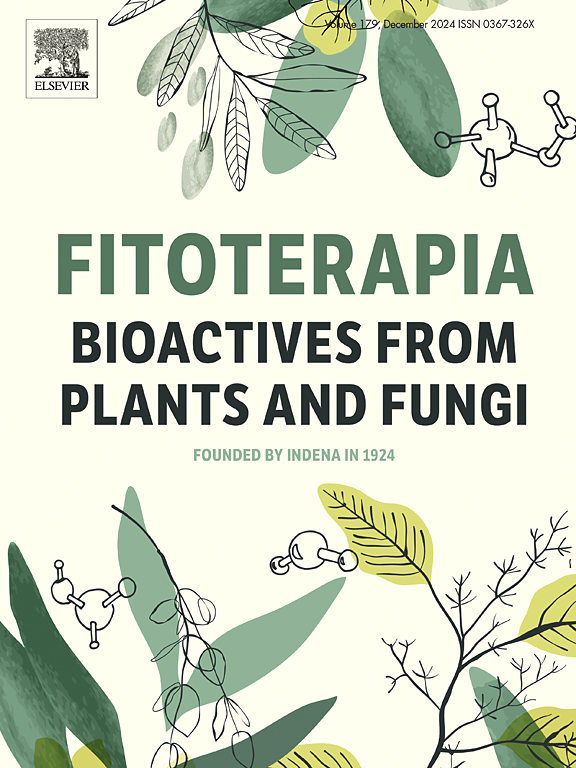Nrf2-dependent cytoprotective effects and depletion of gut microbial energy harvesting by chemically defined polyphenol-rich Clerodendrum infortunatum
IF 2.5
3区 医学
Q3 CHEMISTRY, MEDICINAL
引用次数: 0
Abstract
Plants belonging to the genus Clerodendrum are consumed as functional foods to treat metabolic liver disease in the North-Eastern sub-Himalayan region of India. The use of Clerodendrum spp. as hepatoprotective is mentioned in Ayurveda and Chinese traditional medicinal literatures. This study identifies a particular Clerodendrum spp. with the most superior bioactivity and evaluates the cellular mechanism behind its cytoprotective activities and its favorable impact on the gut microbiota. Twelve major Clerodendrum spp. were analyzed using GCMS, phytochemical enrichment, pathway analysis, and comparative antioxidant assays were performed. The superior most Clerodendrum sp. was chemically characterized using HPLC and tested against HepG2 and SH-SY5Y cells for cytoprotection using ML385, a pharmacological inhibitor of Nrf2, and its potential to modulate the gut microbiota using 16S rRNA sequencing. Clerodendrum infortunatum was identified as the most bioactive plant sp. with physiologically-relevant free radical scavenging capacities and containing stigmasterol, gallic acid, catechin, syringic acid, vanillic acid, rutin, p-coumaric acid and quercetin. C. infortunatum attenuated intracellular cytoprotective enzymes, lipid peroxidation and protected HepG2 and SH-SY5Y in a Nrf2-dependent manner which were otherwise affected by H2O2-induced cellular injury. C. infortunatum also improved gut microbial diversity, enriched the populations of gut commensals, reduced obesogenic microbes, and attenuated gut microbial metabolic functions associated with increased dietary energy harvesting capacity. In accordance to the traditional medicinal use, our data show that the hepatoprotective effects of C. infortunatum is associated with the enhancement of hepatocellular cytoprotection and a favorable modulation of the gut microbiome.

nrf2依赖的细胞保护作用和肠道微生物能量收集的消耗由化学定义的富含多酚的黄竹
在印度东北亚喜马拉雅地区,作为治疗代谢性肝病的功能性食品食用的植物属植物。在阿育吠陀和中国传统医学文献中都提到了它的保肝作用。本研究鉴定了一种具有最优生物活性的蔓竹属植物,并评估了其细胞保护活性及其对肠道微生物群的有利影响的细胞机制。采用气相色谱法(GCMS)分析了12种主要的Clerodendrum属植物,并进行了植物化学富集、途径分析和比较抗氧化分析。利用高效液相色谱法对其进行化学表征,利用Nrf2药理学抑制剂ML385检测其对HepG2和SH-SY5Y细胞的细胞保护作用,并利用16S rRNA测序检测其调节肠道微生物群的潜力。结果表明,该植物中含有豆甾醇、没食子酸、儿茶素、丁香酸、香草酸、芦丁、对香豆酸和槲皮素,具有生理相关的自由基清除能力。霉霉能减弱细胞内的细胞保护酶、脂质过氧化作用,并以nrf2依赖的方式保护HepG2和SH-SY5Y,否则这些酶会受到h2o2诱导的细胞损伤的影响。霉霉还改善了肠道微生物多样性,丰富了肠道共生菌群,减少了致肥微生物,并减弱了与增加饮食能量收集能力相关的肠道微生物代谢功能。根据传统的医学用途,我们的数据表明,黄皮草的肝保护作用与增强肝细胞保护和调节肠道微生物群有关。
本文章由计算机程序翻译,如有差异,请以英文原文为准。
求助全文
约1分钟内获得全文
求助全文
来源期刊

Fitoterapia
医学-药学
CiteScore
5.80
自引率
2.90%
发文量
198
审稿时长
1.5 months
期刊介绍:
Fitoterapia is a Journal dedicated to medicinal plants and to bioactive natural products of plant origin. It publishes original contributions in seven major areas:
1. Characterization of active ingredients of medicinal plants
2. Development of standardization method for bioactive plant extracts and natural products
3. Identification of bioactivity in plant extracts
4. Identification of targets and mechanism of activity of plant extracts
5. Production and genomic characterization of medicinal plants biomass
6. Chemistry and biochemistry of bioactive natural products of plant origin
7. Critical reviews of the historical, clinical and legal status of medicinal plants, and accounts on topical issues.
 求助内容:
求助内容: 应助结果提醒方式:
应助结果提醒方式:


